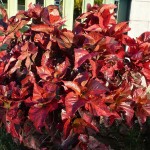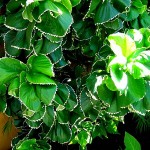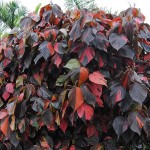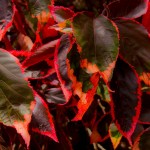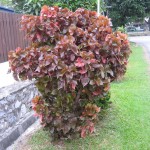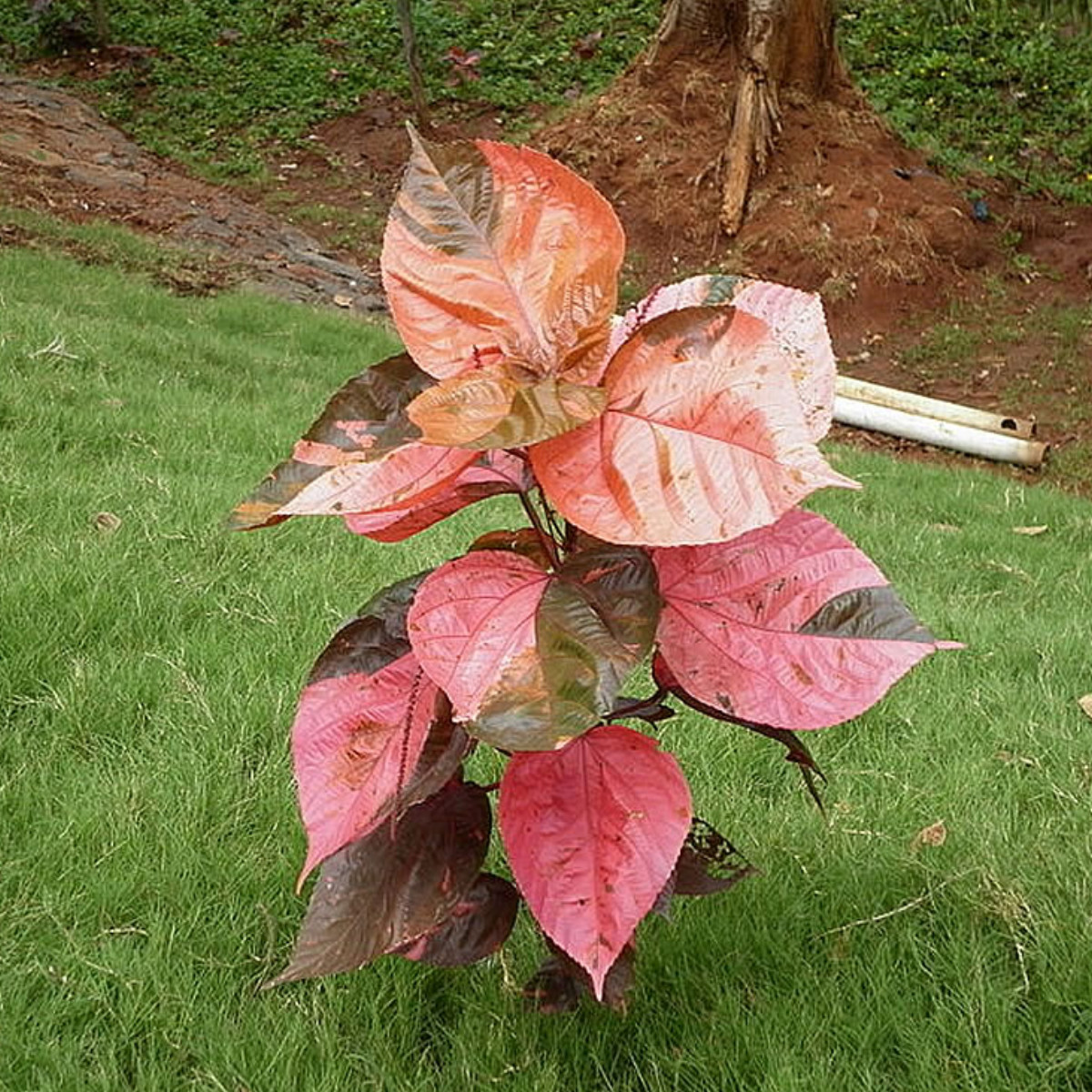Family: Euphorbiaceae
Synonymous: Acalypha circinata
Acalypha compacta
Acalypha godseffiana
Acalypha hamiltoniana
Acalypha illustris
Acalypha macafeeana
Acalypha macrophylla
Acalypha marginata
Acalypha musaica
Acalypha torta
Acalypha tricolor
Acalypha triumphans
Ricinocarpus wilkesianus
Distribution and habitat: Acalypha wilkesiana isshrub which occurs in tropical and subtropical rainforest, dry rainforest and vine thickets of the Pacific Islands.
Description: Acalypha wilkesiana is an evergreen shrub which can grow to 1.8m (6 feet)tall. The stem is erect with many branches. The branches have fine hairs. It has a closely arranged crown. Its pointed oval leaves which are about 12cm (5 inch)long and 5cm (2 inch)wide, are coppery green, mottled and streaked with copper, red and purple. The leaves are finely hairy. They can be flat or crinkled. The flowers are reddish in spikes at the end of branches. They have separate male and female flowers on the same plant. The male flowers are in long spikes which hang downwards while the female flowers are in short spikes. They do not show up easily as they are often hidden among the leaves.
Acalypha wilkesiana plants are prized for their attractive foliage rather for their insignificant flowers.
Houseplant care: Acalypha wilkesiana branch and become bushy naturally and therefore it is never necessary to pinch out growing tips. But,to keep these plants within bounds in warm areas, they may need to be cut back annually and severely (taking out at least half the previous year's growth). Rather to do this, indoor plants are renewed from cuttings each year and discarded the overgrown plants.
Light: Acalypha wilkesiana plants need plenty of warmth and light. In inadequate light they tend to become spindly andthey will lose much of the leaf colouration that makes these plants so attractive.
Temperature: Warmth is essential. Even during the winter rest period the temperature should not be permitted to fall below 16C (61F). Acalypha wilkesiana will thrive in temperatures as high as 27C (81F). But because they are particularly sensitive to dry air, the potted plants must be set on trays of moist pebbles or damp peat moss throughout the year.
Watering: During the active growth period water plentifully as often as necessary to keep the potting mixture thoroughly moist, but never let the pot stand in water. During the winter rest period water only enough to keep the mixture from drying out.
Feeding: Apply standard liquid fertiliser every two weeks during the active growth period only.
Potting and repotting: Use a soil based potting mixture. Move small plants into pots one size larger whenever, on examination, roots are seen to fill their pots. This is best done in late spring but may be needed more than once a year. If Acalypha wilkesiana plants are to be kept more than one year, they should be repotted into larger pots annually in late spring.
Gardening: Acalypha wilkesiana is best grown as annual bedding plants or in containers which can be overwintered indoors. Stems may be pinched to control size and shape and to promote bushiness. Cutting back once a year keeps the foliage fresh and well coloured, and the plant more compact.
It is damaged by both drought and frost. It needs a minimum temperature above 10C (50F).
Position: Acalypha wilkesiana plants grow in full sun to part shade, sheltered from strong winds. Best foliage colour is optionedin full sun. In hot climates it suits a protected shady position.
Soil: Acalypha wilkesiana prefers light well drained, average to moderately fertile soil. Some sand to loamwithin 5.5 to 7 pH range will suit these beautiful plants.
Irrigation: The soil must be kept consistently moist for Acalypha wilkesiana plants. If soil dry out, rapid leaf drop usually occurs.
Do not overwater during winter months; slightly dry is better.
Fertiliser: A mixture of all purpose fertilizer and potash can be used in spring; the potash will enhance the leaf colours.
Propagation: Acalypha wilkesiana are most attractive when young. Plants are usually discarded in their second year after being used for propagation. The simplest way to increase a plant is to take tip cuttings 8-10cm (3-4 inch)long in early spring. Alternatively, short side-shoots can be used. To encourage side-shoots, in early spring cut the old plant down to0.5m(1 foot)from the potting mixture. Keep the plant in bright filtered light. Mist-spray Acalypha wilkesiana daily and water enough to keep the potting mixture moist.
When new side-shoots are 8-10cm (3-4 inch)long they should be removed - each with a heel attached. After taking either tip or side-shoot cuttings, place each in a 8cm (3 inch) pot containing a moistened mixture of equal parts of peat moss and coarse sand or a substance such as perlite. Enclose the pots in plastic bags and place them in bright light filtered at a temperature of at least 20C (68F). No further watering is required until new growth indicates that the cuttings have taken root. Then remove the plastic bags. Thereafter, water just enough to keep the potting mixture barely moist and feed the plant with half strength liquid fertiliser every two weeks.
When cuttings are 30cm (12 inch)tall, move them into 10cm (4 inch)pots containing the regular potting mixture. They can then be treated as mature plants.
Problems:
Indoors, scale insects, spider mites, whiteflies, and mealybugs may be problems. Keep a careful watch for mealy bugs and red spider mites to which these plants are especially vulnerable. If unnoticed, such pests can do untold damage.
Treatment: Mealybugs - Remove manually the infested parts of the plant. Dip a cotton swab in alcohol and apply it to any bugs you cannot remove or areas which the bugs have heavily occupied. Discard infected plants if prior steps are not enough to eradicate the bugs.
Red spider mites - Wash the affected plants with soft dish soap solution or use an insecticidal soap. Repeat two or three time this treatment.
In the garden, downy mildew, powdery mildew, rust leaf spots and fungal root rots can occur.
Treatment: Prevention is more efficient than controlling the fungal disease. Provide adequate air circulation andwaterthe plants in the morning,so plants get a chance to dry out during the day. However, to combat a fungal disease, use an adequate pesticide.
Recommended varieties:
Acalypha wilkesiana 'Godseffiana' (sometimes called Acalypha godseffiena) has shiny green leaves with creamy white margins.
Acalypha wilkesiana 'Macrophylla' has leaves more nearly heart shaped than oval, of russet-brown with pale brown margins.
Acalypha wilkesiana 'Marginata' has heart shaped, olive green leaves tinged with bronze and margined with a line of carmine-red.
Acalypha wilkesiana 'Mosaica' called the giant red leaf, has hart shaped leaves that are bronze-green with orange and red markings.
Uses and display: Typically grown as an annual or houseplant. Acalypha wilkesiana can be grown in a warm greenhouse, in a border or as a specimen or hedging plant (especially in warm areas). Bedding plant, filler in borders or container plant as focal point will provide stunning colour addition to any display.
SUMMARY:
CHARACTERISTICS:
Foliage coloured
Shape bushy
PROPER CARE:
Watering inrest period sparingly
Watering in active growth period plentifully
Light bright filtered
Temperature inrest period min 16C max 24C (61-75F)
Temperature in active growth period min 18C max 27C (64-81F)
Humidity high
Height indoors: 90cm 120cm (35-47 inch)
Height outdoors: 1.2-1.8m ( 4-5 feet)
Spread outdoors: 1.2-1.8m ( 4-5 feet)
Hardiness zone: 10a-11
